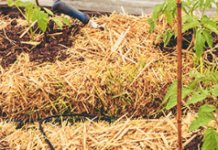Vegetables donated to food pantries through ‘After the Harvest’
OLATHE, Kan. — On a pretty fall afternoon in northeast Kansas recently, volunteers quickly and quietly moved through a field, picking ripe tomatoes and peppers. The “gleaners” were gathering fresh produce at Kansas State University’s Olathe Horticulture Research and Extension Center to be donated to food pantries in the region.
A nonprofit organization, After the Harvest, coordinates the volunteers, who go through farm fields like this after growers have harvested their crops to glean whatever is left of the still-nutritious, healthy fruits and vegetables, keeping them from going to waste. Then, they donate them to agencies that serve hungry people, primarily in the greater Kansas City area.
This year, the K-State horticulture center donated 16,163 pounds of vegetables, up from 3,450 pounds in 2016.
“Our volunteers glean after the harvest, picking what’s left in farmers’ fields and picking up already harvested leftover produce,” said Lisa Ousley, executive director of After the Harvest. “The majority of the funds we raise help secure semi-truckloads of donated produce that might otherwise end up in landfills. After the Harvest is the largest produce donor to Harvesters – Community Food Network.”
In K-State’s case, the produce is left over from vegetable research trials conducted at the center, which is located a few miles west of Olathe.
“We’ve got a bunch of different research projects going on right now and as a result, we’ve been harvesting tons of produce all summer,” said Cary Rivard, K-State associate professor of horticulture and the center’s director. “Most of the research trials are supported by USDA-NIFA grant programs and seek to help our local vegetable farmers improve their productivity, sustainability, or the nutritional quality of their produce.”
“It’s not within our mission to sell produce from our trials, so we are excited to have such a great partnership with After the Harvest,” Rivard said. “I’ve worked at research stations in other states that simply compost their produce due to the added time and energy it takes to distribute it before it rots. This collaboration allows us to be able to give back to the community while still accomplishing our mission of helping vegetable farmers in our area to build the local food system.”
Rivard credited graduate student Zac Hoppenstedt with making the initial connection with After the Harvest. Hoppenstedt is earning a master’s degree in horticulture with an emphasis in urban food systems through K-State Olathe.
With the help of a specially-outfitted van called The Glean Machine, After the Harvest volunteers made 17 trips to the K-State location this year to gather vegetables once the university’s staff and graduate students had harvested what they needed for their research projects.
“It is growers like the K-State Olathe Horticulture Research and Extension Center who make a real difference in eliminating food waste and providing our hungry neighbors with nutritious, healthy food,” Ousley said. “We cannot thank them enough for making the call to After the Harvest when there is excess produce so that our gleaners can harvest it and bring it to those who need it most.”
More information about After the Harvest is available at aftertheharvestkc.org. Learn more about the K-State Olathe Horticulture Research and Extension Center at http://www.kstateohrec.org/ or on Facebook at https://www.facebook.com/KStateOHREC




